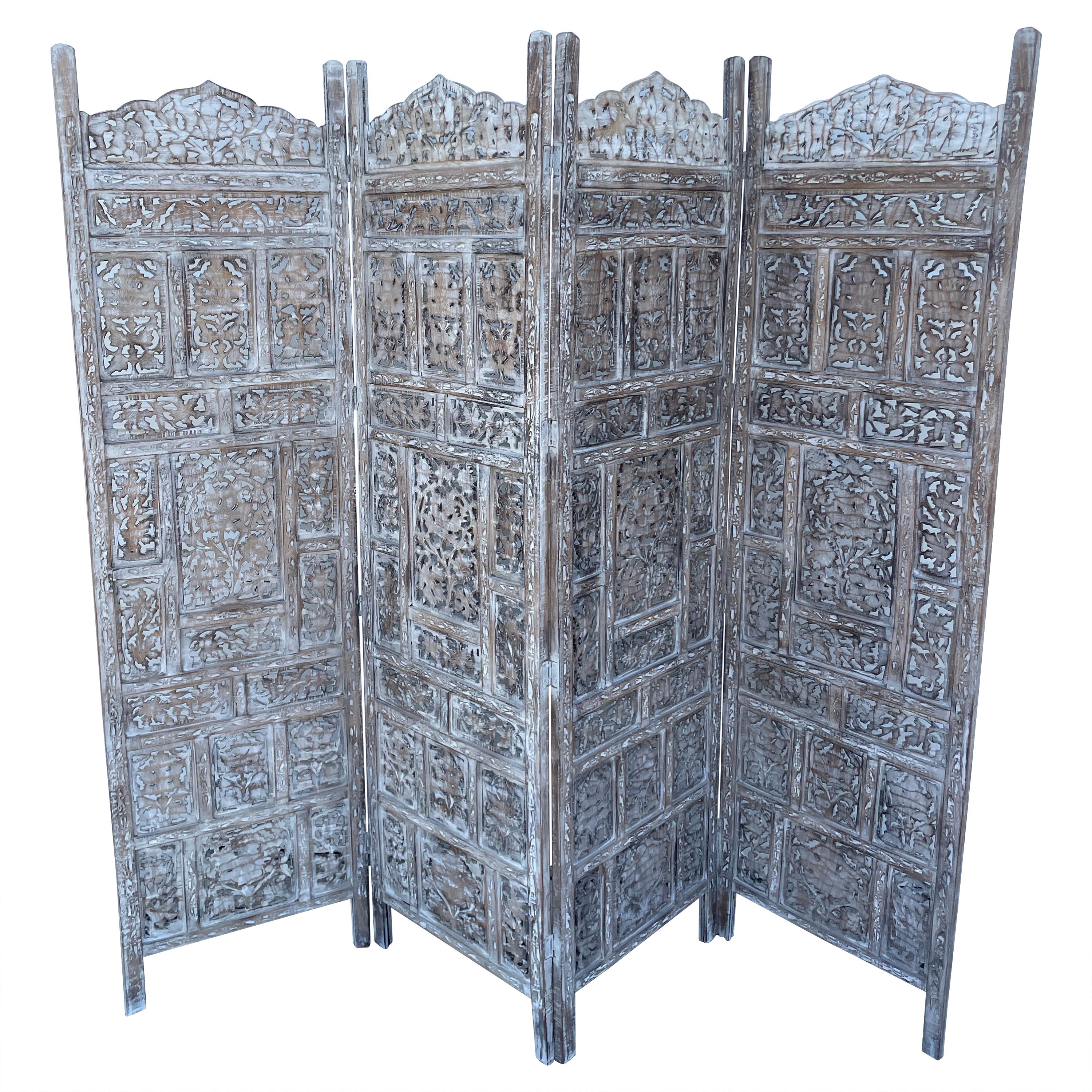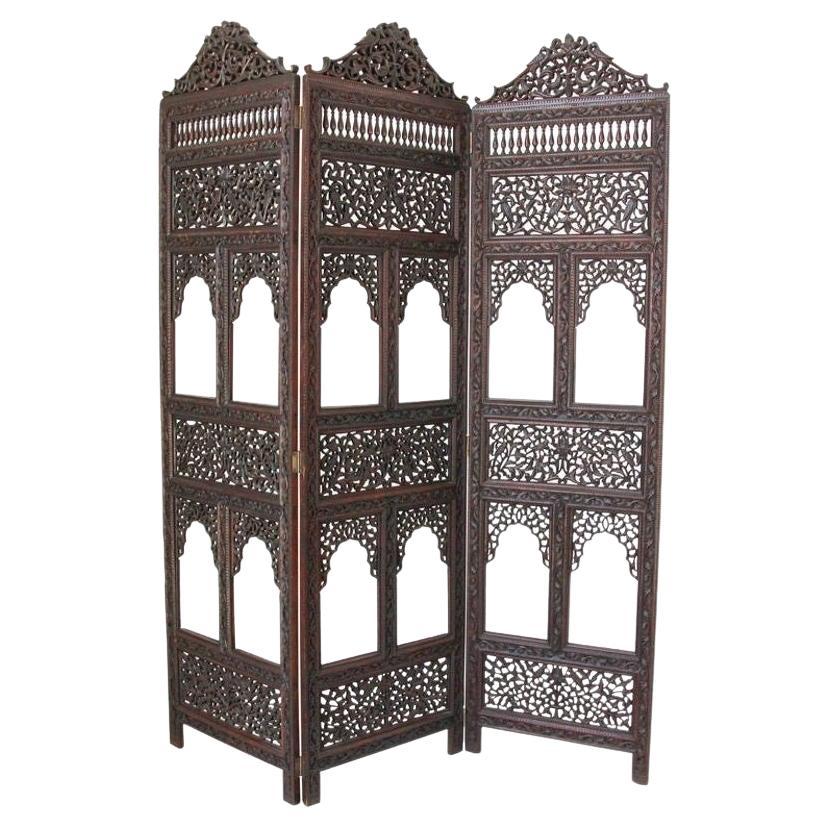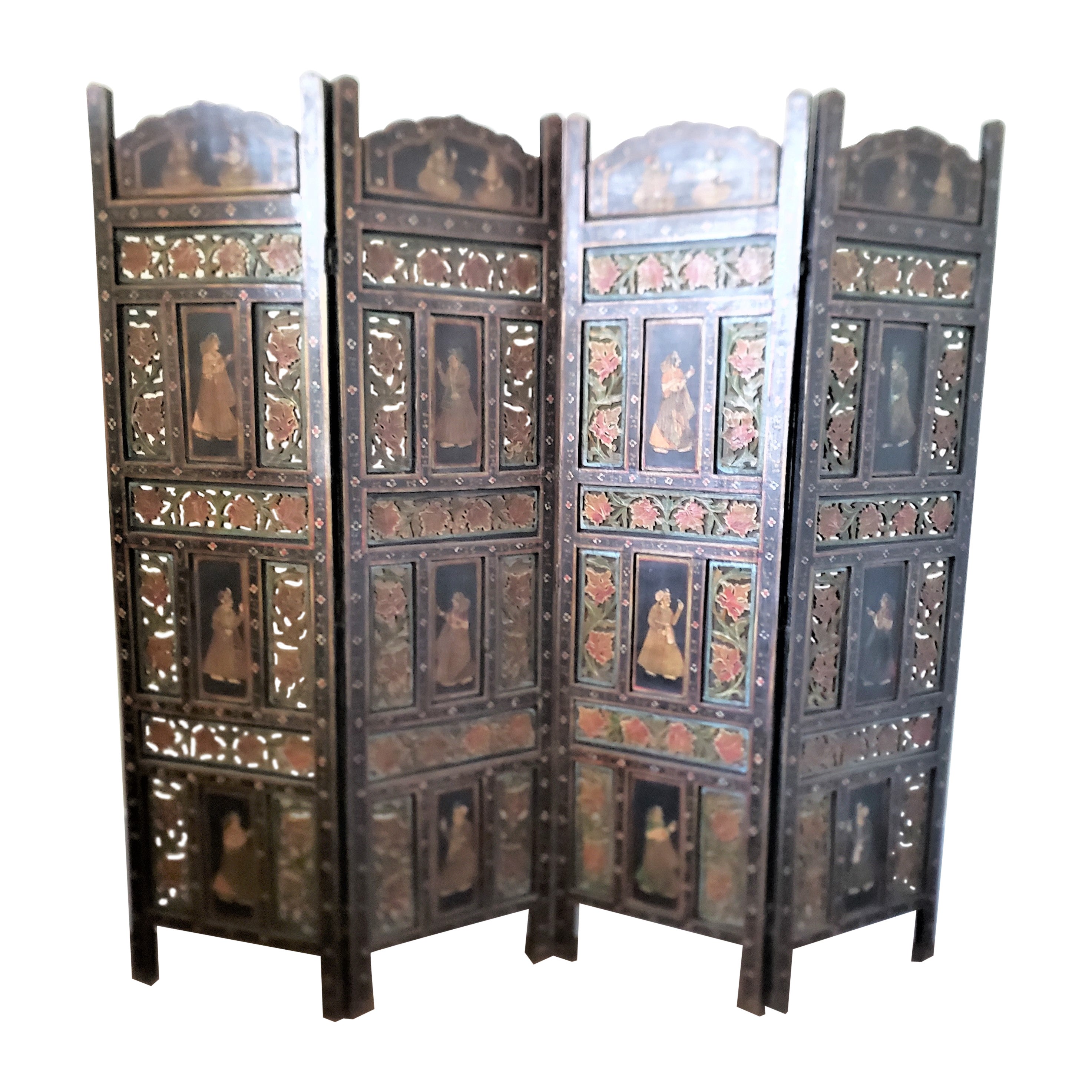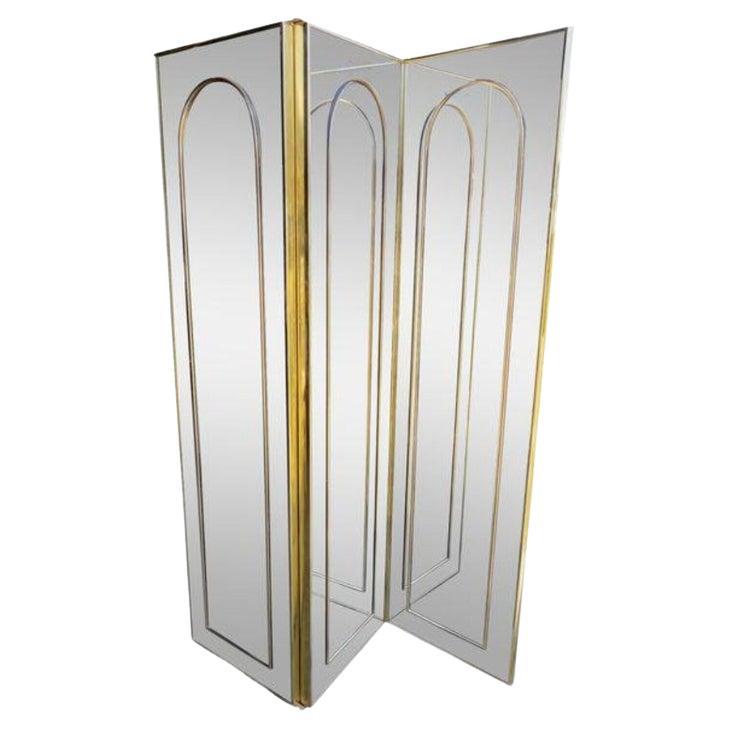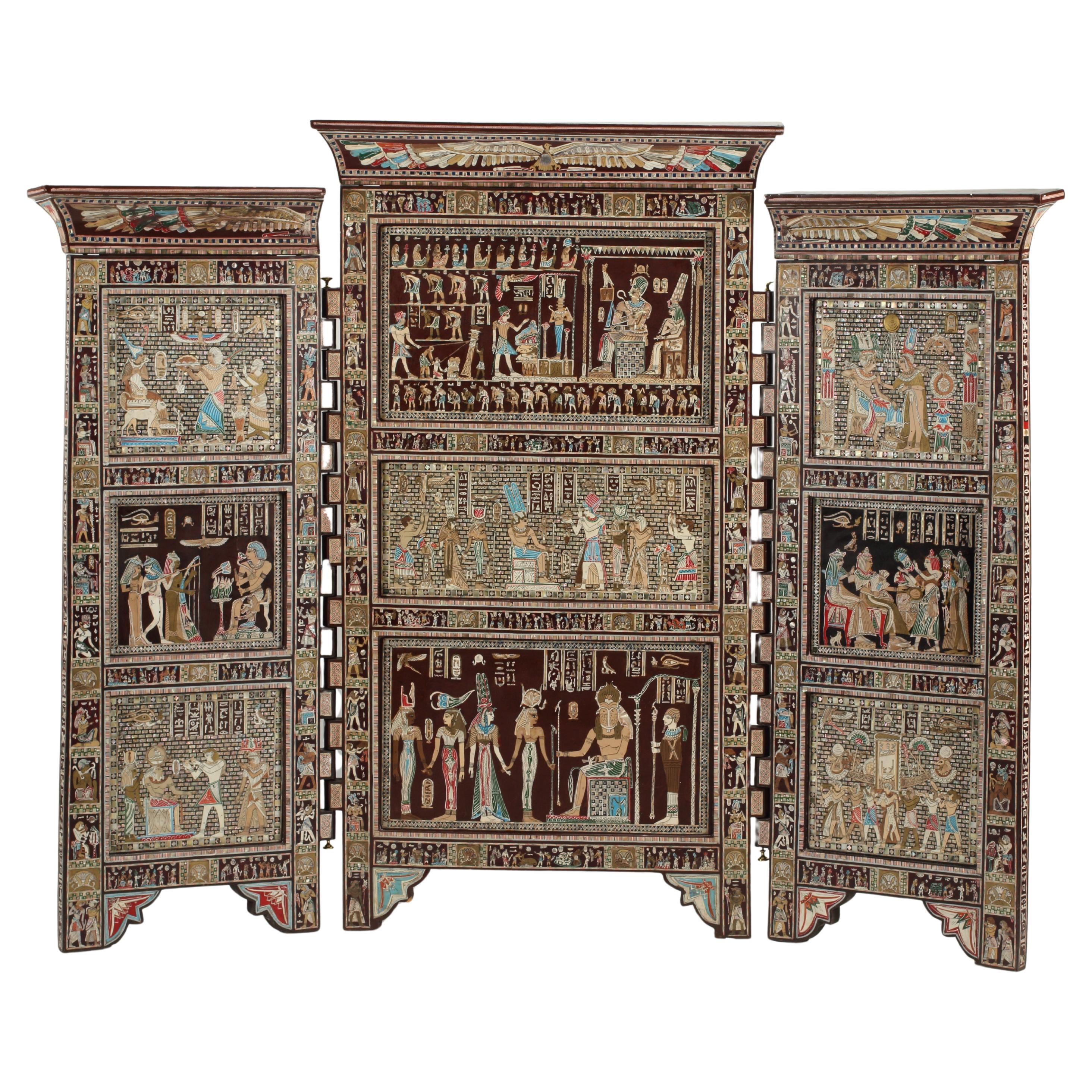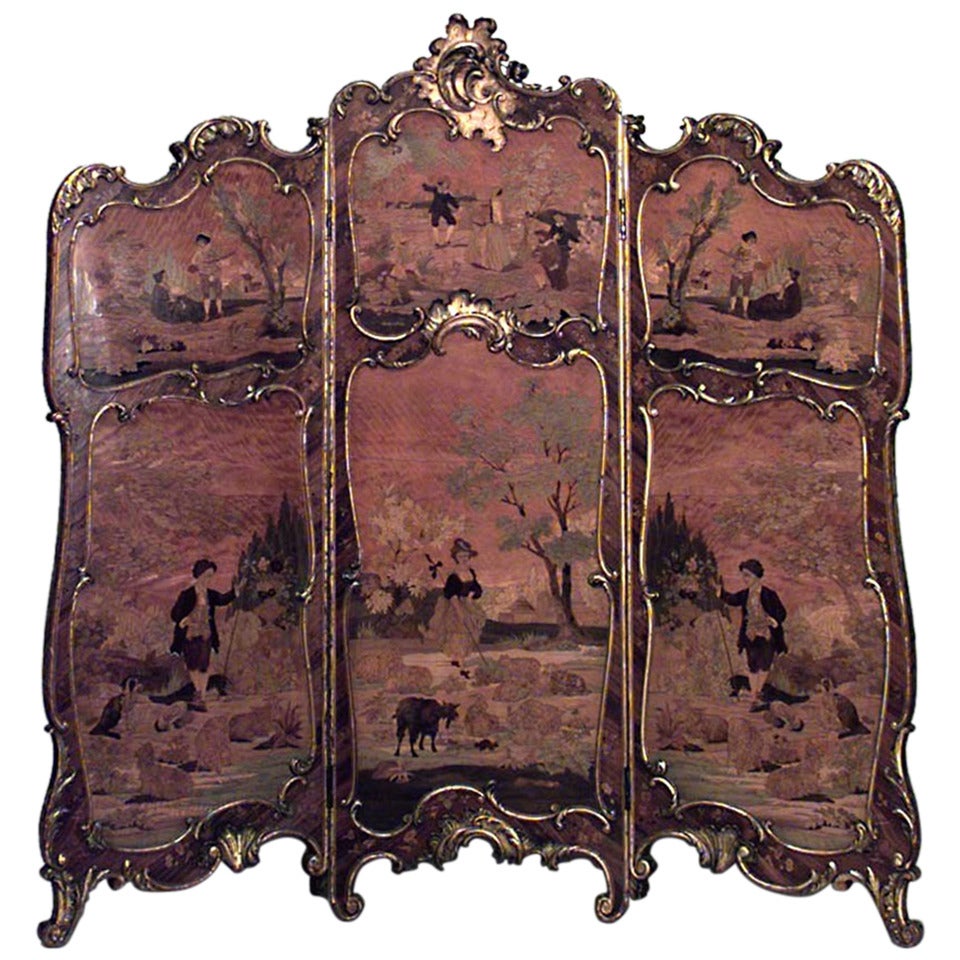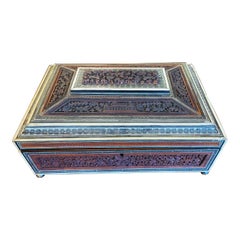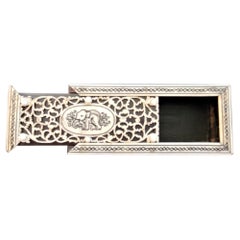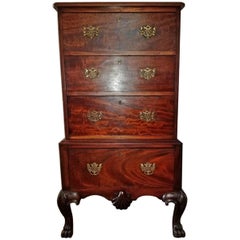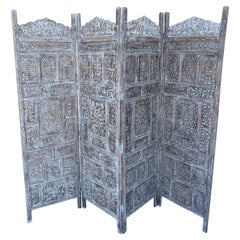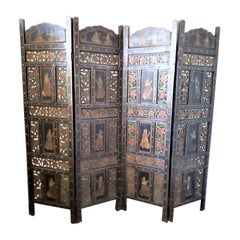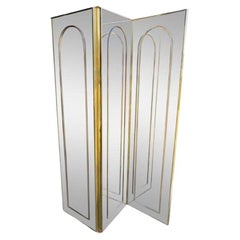Items Similar to 20C Anglo Indian Style Double Sided Profusely Inlaid 4 Panel Screen
Want more images or videos?
Request additional images or videos from the seller
1 of 21
20C Anglo Indian Style Double Sided Profusely Inlaid 4 Panel Screen
About the Item
PRESENTING AN EXCEPTIONAL 20C Anglo Indian Style Double Sided Profusely Inlaid 4 Panel Screen or Room Divider.
Made in Hoshiarpur, India, circa 1960-80.
Made of ‘teak’ wood in the Mughal Style, with pierced frieze panels and profusely inlaid with white plastic (faux ivory), to replicate earlier, ivory inlaid Hoshiarpur craftsmanship.
NOTE: We have tested the inlay and there is no elephant ivory in this piece and therefore it is 100% legal under CITES restrictions. The use of plastic/resin, rather than elephant ivory, tells us that this is a 20th Century piece.
It is a 4 panel, hinged, foldable screen and double sided.
Each panel is of identical construction, design and decoration … front and back.
The crown/top section has an arched and curved, Mughal or Islamic arched style top, a central inlaid faux ivory peacock and pierced frieze surround.
Below this is another pierced frieze panel.
Then it has a solid and profusely inlaid rectangular panel which is edged with faux ivory and ebony chevrons, floral inlay inside that and then an oval inlaid central medallion featuring 3 Elephants, a Lion and 2 Deer.
The lower central section features a rectangular vertical solid panel which is edged with faux ivory and ebony chevrons, then an inlaid central section featuring a ‘fabulous’ Peacock, perched up on a leafy tree branch, with flowing plumes extending downwards.
The base central panel again features a central inlaid faux ivory peacock and pierced frieze surround, to replicate the one on top.
All the side and cross supports (holding the panels in place) are inlaid with faux ivory floral decorations and each side pillar ends with an inlaid ‘urn’.
The inlaid animals ALL have been hand-painted using traditional Indian ‘lac’ ink.
THIS IS A CLASSIC example of the type of furniture that was being made by expert craftsmen in Hoshiarpur, from the early 1700’s .. up to this very day.
Up to Indian independence in the 1950’s, almost all of this furniture, was made for export and specifically for sale to British Military Officers, Diplomats and visiting “Nobility/Gentry’.
WHEN IT COMES TO HOSHIARPUR INLAID FURNITURE … THIS IS AS GOOD AS IT GETS!
Provenance: From a Quality Houston, TX Estate
Dimensions: Each Panel is 72 inches tall, 20 inches wide and 0.75 inches deep
Fully Opened the Screen is 72 inches tall, 80 inches wide and 0.75 inches deep
Fully Closed the Screen is 72 inches tall, 20 inches wide and 4 inches deep.
Condition: Very good original condition. No losses of inlay to any of the main panels. No missing, broken or cracked frieze panels. Some very slight fading and bowing/warping through age, but not significant.
- Dimensions:Height: 72 in (182.88 cm)Width: 20 in (50.8 cm)Depth: 4 in (10.16 cm)
- Style:Anglo-Indian (In the Style Of)
- Materials and Techniques:
- Place of Origin:
- Period:
- Date of Manufacture:1960-80
- Condition:Wear consistent with age and use. Minor losses. Minor structural damages. Minor fading. Very good original condition. Some very slight fading and bowing/warping through age, but not significant.
- Seller Location:Dallas, TX
- Reference Number:1stDibs: LU3978138753732
About the Seller
4.9
Platinum Seller
Premium sellers with a 4.7+ rating and 24-hour response times
Established in 2015
1stDibs seller since 2018
387 sales on 1stDibs
Typical response time: 1 hour
- ShippingRetrieving quote...Shipping from: Dallas, TX
- Return Policy
Authenticity Guarantee
In the unlikely event there’s an issue with an item’s authenticity, contact us within 1 year for a full refund. DetailsMoney-Back Guarantee
If your item is not as described, is damaged in transit, or does not arrive, contact us within 7 days for a full refund. Details24-Hour Cancellation
You have a 24-hour grace period in which to reconsider your purchase, with no questions asked.Vetted Professional Sellers
Our world-class sellers must adhere to strict standards for service and quality, maintaining the integrity of our listings.Price-Match Guarantee
If you find that a seller listed the same item for a lower price elsewhere, we’ll match it.Trusted Global Delivery
Our best-in-class carrier network provides specialized shipping options worldwide, including custom delivery.More From This Seller
View All19C Anglo Indian Highly Carved Teak Sadeli Mosaic Inlaid Sewing Box
Located in Dallas, TX
PRESENTING A LOVELY 19C Anglo Indian Highly Carved Sadeli Mosaic Inlaid Sewing Box.
Made in Bombay, India, circa 1880.
The box is made of sandalwood with highly carved raised teak wood panels on all sides, depicting temple scenes, animals and foliage.
The box is in a sarcophagus form.
It is edged in bone (and we can tell it is bone and not ivory, from the color and evidence of capillaries, which are not found in ivory), and banded with Bombay Sadeli mosaic and ebony veneer.
The lid opens to reveal a removable tray with various open compartments and lidded compartments. 5 lidded compartments, 1 unlidded compartment and 8 holders for thimbles, etc
The tray lifts to reveal a blue velvet (original) lined section, for storing jewelry etc, with sections for collars etc.
The inside of the lid has a removable mirror (the mirror is missing on this one but can easily be replaced). Behind the mirror is the original green velvet lining.
It has its original brass carry handles on the sides and sits on 4 silvered button feet (of recent origin).
Some repairs to the exterior and condition issues (priced accordingly), but still a LOVELY COLLECTIBLE box!
These boxes were made by superb Indian craftsmen, specifically for sale to the ruling British elite. These types of boxes, carved padouk and sandalwood, (whilst beautiful and superbly crafted) were of a lesser quality, than the more profusely and intricately mosaic inlay, tortoiseshell and ivory boxes, made for the British ‘Upper Classes’ in the areas of Bombay and Vizagapatam. These type of boxes were much more affordable back in 1880 (and indeed today) and would probably have been bought by mid-level diplomats, civil servants or visitors.
Sewing boxes (in general), were in EVERY Victorian home in Britain in the 19th century and like other boxes etc were ‘status symbols’ of your place in society! The more ornate the box, the more ‘Upper Class’ you were!
SADELI MOSAIC: “Anglo Indian boxes were made in India for the English residents from the early part of the 18th century. They were brought back or sent back to England usually by the people who had commissioned them. From the beginning of the nineteenth century they were imported more commercially, although not in any significant numbers until the middle decades. They were very highly valued, especially the early ones, to the extent that the designs were copied on late 19th and early 20th century tins.
The ancient art of Sadeli Mosaic is said to have been introduced from Shiraz in Persia via Sind to Bombay, a long time before the Anglo Indian boxes were made. It was a technique, which required a high degree of skill and patience. It was executed very lavishly, in that the frequent cuts wasted a great amount of the precious materials used. The workmanship was however more than commensurable to the value of the materials.
Ivory, silver, pewter (or other metals), wood and Horn were cut into faceted rods which were bound together to form geometric patterns. When the glue has set, the rods were sliced in transverse sections. This gave the maker a number of angled circular pieces in the original pattern. Several variations of patterns could be achieved by combining the materials in different ways. The ivory was sometimes dyed green to give an extra color.
The mosaic pieces in a combination of patterns, often separated by ivory, ebony, Horn or silver stringing were used to veneer sandalwood boxes. In the early boxes, which date from the turn of the 18th to the 19th century, there are large panels of mosaic covering tops and sides of boxes. It took incredible skill to cover such large areas without any shakes or wavering of the pattern. The corners and joins on these boxes are impeccably matched.
The makers (reputed to be Persian) of Sadeli mosaic made in the first two decades of the 19th century displayed a total understanding of the qualities of the different materials they used. They combined substances, which can expand and contract according to atmospheric conditions with others, which are hard and unyielding. The result was a sharp definition of the lines and patterns, which made up the whole design.
On the early boxes the designs look deceptively simple. The fact is, they emerged from a culture, which had mastered geometry and understood how to generate a pattern from a set number of points. The patterns are so harmoniously combined that their incredible complexity is not immediately apparent.
The earliest Sadeli boxes...
Category
Antique Late 19th Century Indian Anglo-Indian Decorative Boxes
Materials
Bone, Sandalwood, Teak
19C Anglo Indian Vizigapatam Stamp Box
Located in Dallas, TX
Presenting an absolutely gorgeous and very rare 19C Anglo Indian Vizigapatam stamp box.
Made in Colonial India (the Time of the Raj) circa 1860.
Prob...
Category
Antique Mid-19th Century Indian Anglo-Indian Decorative Boxes
Materials
Bone, Shell
19C Anglo Indian Silver Perfume Bottle Case
Located in Dallas, TX
19C Anglo Indian solid silver perfume bottle case.
Lovely 19th century Anglo-Indian solid silver perfume bottle case with profuse repousse work.
Not hallmarked because it was m...
Category
Antique Late 19th Century Indian Anglo Raj Sterling Silver
Materials
Sterling Silver
Early 20C Irish Georgian Style Mahogany Low Boy.
Located in Dallas, TX
PRESENTING A LOVELY Early 20C Irish Georgian Style Mahogany Low Boy.
VERY NICE Irish Mahogany Low Boy, chest of 3 drawers, on stand.
Additional drawer on stand, making 4 drawers in...
Category
Early 20th Century Irish George III Commodes and Chests of Drawers
Materials
Brass
20C Chinese Soapstone Polished Bowl
Located in Dallas, TX
Presenting a lovely 20C Chinese soapstone polished bowl.
Made in China in the early 20th century circa 1930.
This is a medium sized jade green an...
Category
Early 20th Century Chinese Chinese Export Sculptures and Carvings
Materials
Soapstone
20C Burgundy Executive Swivel Chair
Located in Dallas, TX
Presenting a lovely 20c burgundy executive swivel chair with beautiful detail.
This chair was made in the mid to late 20th Century, bu...
Category
20th Century American Edwardian Office Chairs and Desk Chairs
Materials
Faux Leather, Satinwood, Walnut
You May Also Like
Vintage Anglo Indian Four Panel Screen
Located in West Palm Beach, FL
Vintage carved whitewashed four panel Anglo Indian folding screen. Each panel measures 20" by 73". A great accent piece or room divider.
Category
20th Century Indian Anglo-Indian Screens and Room Dividers
Materials
Wood
Anglo-Indian Mughal Hardwood Three-Panel Screen
Located in North Hollywood, CA
Anglo-Indian hardwood three-panel Screen.
This is a beautifully carved sculptural hardwood Anglo-Indian Wooden Mughal screen in Victorian colonial Raj.
T...
Category
Antique Late 19th Century Indian Anglo Raj Furniture
Materials
Hardwood
Antique Anglo-Indian Hand-Painted Wooden Four Panel Screen or Room Divider
Located in Hamilton, Ontario
This four hinged panel screen or room divider has no maker's label or signature, but is presumed to have originated from India and date to approximately ...
Category
Early 20th Century Indian Anglo-Indian Screens and Room Dividers
Materials
Softwood
3 Panel Double Sided Mirror Screen / Room Divider
Located in Dallas, TX
Mid century mirrored screen / room divider. The three panels are mirrored front and back, with the front side featuring brass arches. Panels meet at top and bottom hinges to stand in...
Category
Vintage 1970s Hollywood Regency Screens and Room Dividers
Materials
Brass
Egyptian Revival Inlaid Screen, Three Panel and Double Faced
Located in El Monte, CA
A remarkable three-panel, double faced Egyptian Revival screen that displays the iconic motifs of ancient Egypt with masterfully inlaid and hand-painted scenes. Each panel is adorned...
Category
20th Century Egyptian Egyptian Revival Screens and Room Dividers
Materials
Mother-of-Pearl, Wood
French Louis XV Style 3-Fold Screen with Inlaid Panels
Located in Queens, NY
French Louis XV style (19th Century) 3 fold screen with inlaid scenes and gilt trim.
Category
Antique 19th Century French Louis XV Screens and Room Dividers
Materials
Gold Leaf
Recently Viewed
View AllMore Ways To Browse
Vintage 80s Collectibles
Anglo Indian Teak
Indian Arch
Ivory Inlaid
Teak Tree
Cross Teak
Arch Room Divider
Indian Wood Screen
Oval Room Divider
Anglo Indian Ebony
Islamic Arch
Solid Wood Elephant
Tree Cross Section
Mughal Teak
Wood Panel Islamic
Anglo Indian Screen
Hand Carved Teak Elephant
Anglo Indian Mughal Teak Wood
